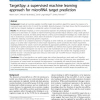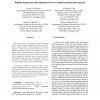20 search results - page 4 / 4 » Use of machine learning algorithms to classify binary protei... |
BMCBI
2010
13 years 5 months ago
2010
Background: The prediction of protein-protein interactions is an important step toward the elucidation of protein functions and the understanding of the molecular mechanisms insid...
BMCBI
2010
13 years 5 months ago
2010
Background: Virtually all currently available microRNA target site prediction algorithms require the presence of a (conserved) seed match to the 5' end of the microRNA. Recen...
CSB
2005
IEEE
13 years 11 months ago
2005
IEEE
Mass spectrometry is a particularly useful technology for the rapid and robust identification of peptides and proteins in complex mixtures. Peptide sequences can be identified b...
ICML
2009
IEEE
14 years 6 months ago
2009
IEEE
We introduce a new algorithm for binary classification in the selective sampling protocol. Our algorithm uses Regularized Least Squares (RLS) as base classifier, and for this reas...
BMCBI
2010
13 years 5 months ago
2010
Background: Machine learning techniques have shown to improve bacterial species classification based on fatty acid methyl ester (FAME) data. Nonetheless, FAME analysis has a limit...


